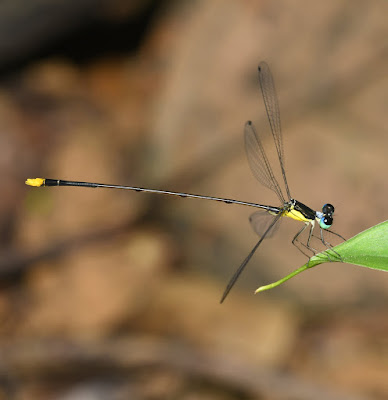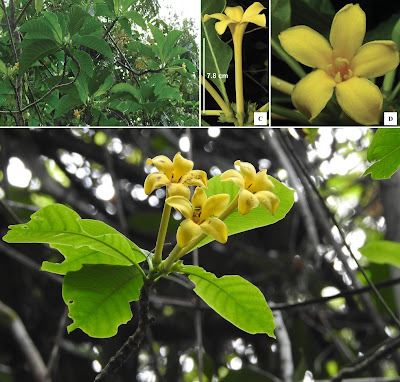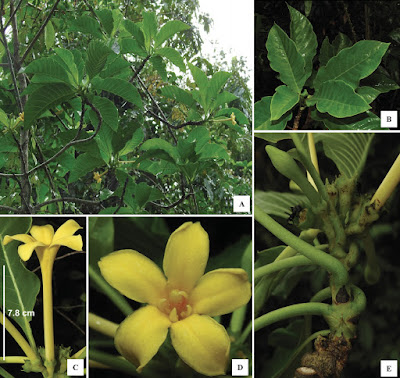[Most Recent Entries] [Calendar View]
Saturday, January 2nd, 2021
| Time | Event | ||||
| 8:18a | [Entomology • 2020] Coeliccia natgeo • A New Species of Coeliccia (Odonata: Zygoptera: Platycnemididae) from Central Vietnam with Keys to the Males and Females of the hayashii-group
Abstract Coeliccia natgeo sp. nov. is described from central Vietnam (holotype ♂, 18._ N, 105._ E, Khe Nhop, Vu Quang National Park, Ha Tinh Province, deposited in the Zoological Collection of Duy Tan University, Da Nang City, Vietnam). The new species differs from other members of the hayashii-group by males lacking antehumeral stripes, spots and pruinosity on the synthorax and female having the central part of the posterior pronotal lobe reduced to a small projection. Keys to the males and females of the hayashii-group are provided. Keywords: Odonata, Platycnemididae, Coeliccia hayashii-group, Coeliccia natgeo, new species, Vu Quang National Park, Pu Mat National Park, Vietnam Quoc Toan Phan, Quoc Phu Ngo, Thai Canh Toan and Vo Anh Tuan. 2020. Description of Coeliccia natgeo sp. nov. from Central Vietnam with Keys to the Males and Females of the hayashii-group (Odonata: Zygoptera: Platycnemididae). Zootaxa. 4896(1); 96–104. DOI: 10.11646/zootaxa.4896.1.4 Công bố một loài chuồn chuồn kim mới, Coeliccia natgeo Phan, Ngo, Toan & Tuan, 2020 từ Vườn quốc gia Vũ Quang và Pù Mát, miền Trung Việt Nam. Loài côn trùng mới này có đặc điểm con đực có phấn trắng ở ngực trước (prothorax) và không có sọc hay vạch vàng ở ngực giữa (synthorax), và cấu trúc tấm sau của ngực trước con cái tiêu giảm thành một mấu lồi rất nhỏ. ... | ||||
| 8:55a | [Botany • 2020] Tocoyena atlantica (Rubiaceae, Gardenieae) • A New Species of Tocoyena from the Brazilian Atlantic Forest
Abstract Tocoyena atlantica, a new species endemic to southern Bahia and northern Espírito Santo states, Brazil, is here described and illustrated. The species consists of trees 5−8 m tall; with petioles 2−5 cm long, and leaf blades 7.4−24.5 × 2.5−9.1 cm, elliptic, adaxially glabrous; calyces cup-shaped with triangular lobes; corolla yellow during anthesis, with tube gradually wider towards the mouth; and laterally compressed hypanthia. Based on IUCN criteria, we consider T. atlantica endangered, with three collection localities within the Atlantic Forest domain. An identification key for species of Tocoyena occurring in the Brazilian Atlantic Forest is also provided. Keywords: Atlantic rainforest, endangered species, Bahia, mussununga, Eudicots
Tocoyena atlantica R. Borges & Gaem, sp. nov. Diagnosis:— Tocoyena atlantica differs from the other species of the genus by the leaves clustered on tip of branches and disposed between reduced internodes (2–3 mm long); with petioles 2–5 cm long; calyx distinctly lobed (vs. minutely lobed or truncate in T. formosa, T. sellowiana and T. bullata); and a corolla green in bud passing to yellow during and after anthesis (vs. most of the species having a greenish-white corolla during anthesis, passing to creamyellow after anthesis). It resembles T. longiflora by the triangular calyx lobes, but differs from it by having a corolla ca. 10 cm long (vs. ca. 30 cm in T. longiflora), dichasial or thyrsiform inflorescences (vs. fasciculate), and a laterally compressed hypantium (vs. not compressed). Etymology:— The specific epithet refers to the Atlantic Forest domain, to which the species is endemic. Rodrigo L. Borges, Paulo Henrique Gaem and Nádia Roque. 2020. A New Species of Tocoyena (Rubiaceae, Gardenieae) from the Brazilian Atlantic Forest. Phytotaxa. 470(3); 243–248. DOI: 10.11646/phytotaxa.470.3.4 |
| << Previous Day |
2021/01/02 [Calendar] |
Next Day >> |









